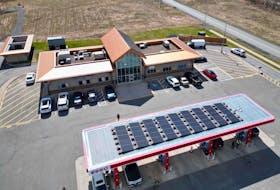The number is below the province’s projected target of 60,000 passengers that it hopes to see for the service, leaving the transportation minister to say continued work lies ahead to market the service for next year.
“Obviously that’s going to be a focus for the tourism sector, TIANS and Tourism Nova Scotia, and Bay Ferries on the marketing side,” said Geoff MacLellan, Minister of Transportation and Infrastructure Renewal.
Still, MacLellan said he feels this new service – introduced this year after two years of ferry service by Nova Star Cruises – is off to a good start with the right “competent and experienced” operator in place.
The province’s 60,000 projection is based on numbers from Nova Star’s two previous seasons, although both of those seasons were longer than the Cat’s was.
In 2014 during a 21-week season Nova Star carried 59,018 passengers. In 2015 during a 19-week season the ferry carried 51,038 passengers. The Cat’s service ran for 15-and-a-half weeks from June 15 to Oct. 1.
The Cat season saw five scheduled non-service days and four days lost to adverse weather and sea conditions, which affected 18 crossings, as the Cat made a daily crossing from Yarmouth to Portland and from Portland back to Yarmouth.
FINANCIAL PROJECTIONS
In an Oct. 6 statement, Bay Ferries said it anticipates that “it will meet the financial projections provided to the Province of Nova Scotia with respect to costs of start-up, vessel refit/rebuild and the first year of operation.”
The company noted that because the fiscal year is not complete until March 31, 2017 unanticipated expenditures could arise. “However,” stated Bay Ferries, “based on present estimates, the original projection will be met and no additional contribution in 2016-2017 should be required.”
The province has committed $9.4 million for the service next year. The province had committed $10.2 million in subsidy this year, along with $4.1 million for start-up costs and terminal upgrades and $9 million towards the ferry’s retrofit.
Bay Ferries said although passenger volumes were lower than anticipated, they expect the numbers to grow as the service gains traction. The motorcoach business volume was also slow, said Bay Ferries, but it expects growth there too if the industry perceives stability and long-term predictability with the service.
TOURISM IMPACT
The Cat arrived late at night and left early in the morning so the bulk of passengers stayed in Yarmouth and the surrounding area on arrival and departure. Some nights it was difficult to find available rooms in Yarmouth due to the ferry traffic.
Neil MacKenzie, general manager of Yarmouth and Acadian Shores Tourism Association (YASTA) says room nights in July had increased by 21 per cent.
"I don't have the numbers for room nights yet for August and Sept but all indicators are that they will be very good as well," said MacKenzie. "This has been a very busy year for the Yarmouth and Acadian Shores Region. We've worked hard with Bay Ferries and Tourism Nova Scotia to market the ferry and the destination. The provincial investment in the International Ferry Link is providing great benefit to South West Nova Scotia and indeed the entire province."
He notes the room nights in the province is up by six or seven percent this year, and that's on top of last year which had also had a six per cent increase.
The majority of passengers who used the Cat ferry had travel plans that took them to destinations throughout the province. MacLellan said the province has heard a tremendous amount of renewed optimism from tourism operators throughout Nova Scotia.
This year Nova Scotia is on target for a record tourism year, and MacLellan said the ferry service has helped to contribute to that.
Bay Ferries says a combination of vessel staff, stevedores, the onboard Sip@Sea contractor, onboard travel counselors, etc. created around 70 jobs in the Yarmouth area for the service. Many provisions for the boat were also purchased in Yarmouth and Nova Scotia. Bay Ferries says, "Every dollar that could be spent in Nova Scotia has been spent in Nova Scotia."
CUTTING COSTS
Both Bay Ferries and the province note the financial side of operations is not based solely on passenger numbers and revenue from that. Bay Ferries says it took an overall cautious and conservative approach to its budget, adjusted crew levels to correspond with passenger loads and took measures to reduce operating costs where it was safe and appropriate.
“As an example, if they were efficient in the onloading and offloading and they got away 20 minutes earlier, if would mean they wouldn’t have to utilize one of the turbo options for an engine, which meant fuel savings,” MacLellan noted, as the vessel was able to travel at more economical operating speeds.
The crossing between Portland, Maine and Yarmouth, Nova Scotia was five-and-a-half hours.
MacLellan said he wouldn’t define the first season blatantly as a success, but said, “we’re moving in a good direction.
“Mark MacDonald and his team were focused on putting the best possible product, the best possible service in place, from our perspective they’ve done that,” the minister said. “I think the stability that Bay Ferries brings to the table is a big part of that and we’re looking to build on that in 2017.”
The province's Progressive Conservative party has been very critical of the ferry agreement struck between the province and Bay Ferries, calling it a "bad deal."
The number is below the province’s projected target of 60,000 passengers that it hopes to see for the service, leaving the transportation minister to say continued work lies ahead to market the service for next year.
“Obviously that’s going to be a focus for the tourism sector, TIANS and Tourism Nova Scotia, and Bay Ferries on the marketing side,” said Geoff MacLellan, Minister of Transportation and Infrastructure Renewal.
Still, MacLellan said he feels this new service – introduced this year after two years of ferry service by Nova Star Cruises – is off to a good start with the right “competent and experienced” operator in place.
The province’s 60,000 projection is based on numbers from Nova Star’s two previous seasons, although both of those seasons were longer than the Cat’s was.
In 2014 during a 21-week season Nova Star carried 59,018 passengers. In 2015 during a 19-week season the ferry carried 51,038 passengers. The Cat’s service ran for 15-and-a-half weeks from June 15 to Oct. 1.
The Cat season saw five scheduled non-service days and four days lost to adverse weather and sea conditions, which affected 18 crossings, as the Cat made a daily crossing from Yarmouth to Portland and from Portland back to Yarmouth.
FINANCIAL PROJECTIONS
In an Oct. 6 statement, Bay Ferries said it anticipates that “it will meet the financial projections provided to the Province of Nova Scotia with respect to costs of start-up, vessel refit/rebuild and the first year of operation.”
The company noted that because the fiscal year is not complete until March 31, 2017 unanticipated expenditures could arise. “However,” stated Bay Ferries, “based on present estimates, the original projection will be met and no additional contribution in 2016-2017 should be required.”
The province has committed $9.4 million for the service next year. The province had committed $10.2 million in subsidy this year, along with $4.1 million for start-up costs and terminal upgrades and $9 million towards the ferry’s retrofit.
Bay Ferries said although passenger volumes were lower than anticipated, they expect the numbers to grow as the service gains traction. The motorcoach business volume was also slow, said Bay Ferries, but it expects growth there too if the industry perceives stability and long-term predictability with the service.
TOURISM IMPACT
The Cat arrived late at night and left early in the morning so the bulk of passengers stayed in Yarmouth and the surrounding area on arrival and departure. Some nights it was difficult to find available rooms in Yarmouth due to the ferry traffic.
Neil MacKenzie, general manager of Yarmouth and Acadian Shores Tourism Association (YASTA) says room nights in July had increased by 21 per cent.
"I don't have the numbers for room nights yet for August and Sept but all indicators are that they will be very good as well," said MacKenzie. "This has been a very busy year for the Yarmouth and Acadian Shores Region. We've worked hard with Bay Ferries and Tourism Nova Scotia to market the ferry and the destination. The provincial investment in the International Ferry Link is providing great benefit to South West Nova Scotia and indeed the entire province."
He notes the room nights in the province is up by six or seven percent this year, and that's on top of last year which had also had a six per cent increase.
The majority of passengers who used the Cat ferry had travel plans that took them to destinations throughout the province. MacLellan said the province has heard a tremendous amount of renewed optimism from tourism operators throughout Nova Scotia.
This year Nova Scotia is on target for a record tourism year, and MacLellan said the ferry service has helped to contribute to that.
Bay Ferries says a combination of vessel staff, stevedores, the onboard Sip@Sea contractor, onboard travel counselors, etc. created around 70 jobs in the Yarmouth area for the service. Many provisions for the boat were also purchased in Yarmouth and Nova Scotia. Bay Ferries says, "Every dollar that could be spent in Nova Scotia has been spent in Nova Scotia."
CUTTING COSTS
Both Bay Ferries and the province note the financial side of operations is not based solely on passenger numbers and revenue from that. Bay Ferries says it took an overall cautious and conservative approach to its budget, adjusted crew levels to correspond with passenger loads and took measures to reduce operating costs where it was safe and appropriate.
“As an example, if they were efficient in the onloading and offloading and they got away 20 minutes earlier, if would mean they wouldn’t have to utilize one of the turbo options for an engine, which meant fuel savings,” MacLellan noted, as the vessel was able to travel at more economical operating speeds.
The crossing between Portland, Maine and Yarmouth, Nova Scotia was five-and-a-half hours.
MacLellan said he wouldn’t define the first season blatantly as a success, but said, “we’re moving in a good direction.
“Mark MacDonald and his team were focused on putting the best possible product, the best possible service in place, from our perspective they’ve done that,” the minister said. “I think the stability that Bay Ferries brings to the table is a big part of that and we’re looking to build on that in 2017.”
The province's Progressive Conservative party has been very critical of the ferry agreement struck between the province and Bay Ferries, calling it a "bad deal."








